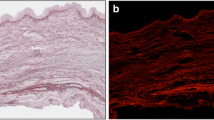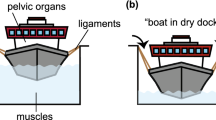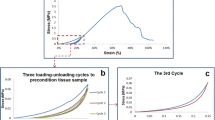Abstract
The aim of this study is to characterise the biomechanical properties of vaginal tissue to develop an accurate cure of pelvic organ prolapse (POP). Prolapsed vaginal tissues were extracted during the prolapse cure of five patients (POP) and on five cadavers without noticed pelvic floor dysfunction (non-pelvic organ prolapse) with agreement of the ethics committee. Uni-axial tension was performed, and the results were analysed. Individual reproducibility of experimental results was good, and the results highlight the non-linear relationship between stress (force per unit of surface) and strain (l − l 0 / l 0) and very large deformation before rupture appearance. This experimental study has proven for the first time that the mechanical behaviour of vaginal tissue has to be defined as hyperelastic with a large deformation. This response has to be taken into account to develop accurate synthetic prostheses for POP cure and in the numerical simulation of the pelvic floor.




Similar content being viewed by others
References
Samuelsson E, Victor F, Tibblin G, Svardsudd K (1999) Signs of genital prolapse in a Swedish population of women 20 to 59 years of age and possible related factors. Am J Obstet Gynecol 180:299–305
Olsen AL, Smith VJ, Bergstrom JO, Colling JC, Clark A (1997) Epidemiology of surgically managed pelvic organ prolapse and urinary incontinence. Obstet Gynecol 89:501–506
Swift SE (2000) The distribution of pelvis organ support in a population of female subjects seen for routine gynecologic health care. Am J Obstet Gynecol 183:277–285
Cosson M, Boukerrou M, Lambaudie E, Lobry P, Crepin G, Ego A (2003) Biomechanics of stress distribution and resistance of biological tissues: why use prostheses for the treatment of genital prolapse? J Gynecol Obstet Biol Reprod 32:329–337
Goh JT (2003) Biomechanical and biochemical assessments for pelvic organ prolapse. Curr Opin Obstet Gynecol 15:391–394
Baden W, Walker T, Lindsay H (1968) The vaginal profile. Tex Med J 64:56–58
Rubod C, Boukerrou M, Brieu M, Dubois P, Cosson M (2007) Biomechanical properties of vaginal tissue. Part 1: New experimental protocol. J Urol 178:320–325
Brown RP (1996) Physical testing of rubber, 3rd edn. Chapman & Hall, London
Duck FA (1990) Physical properties of tissue; a comprehensive reference book. Academic, London
Cosson M, Lambaudie E, Boukerrou M, Lobry P, Crépin G, Ego A (2004) A biomechanical study of the strength of vaginal tissues. Results on 16 post-menopausal patients presenting with genital prolapse. Eur J Obstet Gynecol Reprod Biol 112:201–205
Ettema GJ, Goh JT, Forwood MR (1998) A new method to measure elastic properties of plastic–viscoelastic connective tissue. Med Eng Phys 20:308–314
Goh JT (2002) Biomechanical properties of prolapsed vaginal tissue in pre- and postmenopausal women. Int Urogynecol J Pelvic Floor Dysfunct 13:76–79
Lei L, Song Y, Chen R (2007) Biomechanical properties of prolapsed vaginal tissue in pre- and postmenopausal women. Int Urogynecol J 18:603–607
Mooney M (1947) A theory of large elastic deformation. J Appl Phys 1940(11):582–592
Rivlin RS (1948) Large elastic deformations of isotropic materials. I. Fundamental concepts, II. Some uniqueness theorems for pure homogeneous deformations. Philos Trans R Soc Lond Ser A: Math Phys Sci A240:459–490
Treloar LRG (1975) The physics of rubber, 3rd edn. Clarendon, Oxford
Diani J, Brieu M, Gilormini P (2006) Observation and modeling of the anisotropic visco-hyperelastic behavior of a rubberlike material. Int J Solids Struct 43–10:3044–3056
Conflicts of interest
None.
Author information
Authors and Affiliations
Corresponding author
Additional information
The authors thank the Foundation for Medical Research for financing this study and the ethics committee for their approval.
Rights and permissions
About this article
Cite this article
Rubod, C., Boukerrou, M., Brieu, M. et al. Biomechanical properties of vaginal tissue: preliminary results. Int Urogynecol J 19, 811–816 (2008). https://doi.org/10.1007/s00192-007-0533-3
Received:
Accepted:
Published:
Issue Date:
DOI: https://doi.org/10.1007/s00192-007-0533-3




